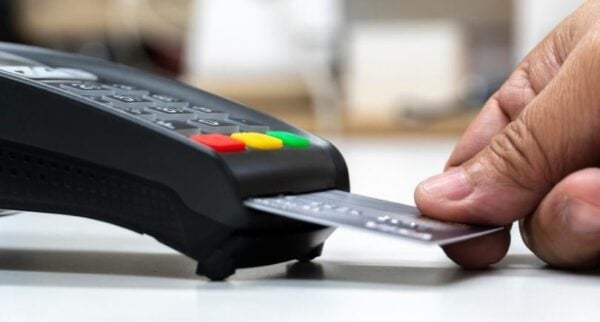Ah, the “fine print.” Often overly complicated and wrapped in eye-straining, microscopic font. Where else can you find phrases like “in accordance with the law” and “terms shall remain in force”?
Yet the fine print should never be ignored, especially in certain areas of life such as credit card agreements.
What is the fine print on a credit card agreement?
Credit card fine print will address many topics that directly affect your wallet. The two most important sections you’ll come across in the fine print of your credit card agreement are:
- Interest rates and interest charges. This will include the annual percentage rate (APR) which will vary according to the market based on the Prime Rate. Depending on the card, there may be different APRs for different situations. For example, standard credit cards will always have a purchase APR, which is the amount you’ll be charged on revolving balances, but there could also be rates for other situations, such as balance transfers and cash advances. These may be the same as your purchase APR, but they could also be different. Those details should be clearly laid out in your credit card’s fine print.
It’s also in this section that you’ll find information about paying interest. For example, the fine print may read something like: “Your due date is at least 25 days after the close of each billing cycle. We will not charge you interest on new purchases, proved you have paid your previous balance in full by the due date each month. We will begin charging interest on cash advances and transfers on the transaction date.” Having a clear understanding of these details can help you avoid unexpected charges.
- Fees. This section will include details for any fees that might be associated with the card such as annual fees, foreign transaction fees, balance transfer fees, cash advance fees, and penalty fees. Learn more about common credit card fees.
Additionally, it’s in the fine print that you’ll find the details to other important card features. Credit card issuers usually make a card’s main perks pretty obvious to people researching credit cards as a way to attract new cardholders, but it’s in the fine print where you’ll find the finer details of those offers. For example, you might already know what a credit card’s welcome bonus, if it has one, is, but it’s in the fine print that you’ll learn the nitty and gritty about the offer. Same goes for things like ongoing rewards. You might already know that a card earns, say, 2X points on eligible purchases, but which categories exactly are eligible? Again, these are the type of things you’ll find in the fine print.
Some credit cards go beyond and above general perks such as welcome bonuses and ongoing rewards, and offer things like 0% intro APR periods, insurance plans, and travel perks like airport lounge access. If you have questions about these offers, your credit card’s fine print should cover the main details.
Why is it important to read the fine print on your credit card?
It’s easy to get lured into applying for a new credit card when you see flashy perks like “$200 cash back for new cardholders” or “0% intro APR for 12 months” advertised. It’s risky, though, to apply for a card for these types of offers without first reviewing the fine print.
Credit card issuers usually make the main details of their cards pretty obvious to consumers, but sometimes in the excitement of things, important details can get overlooked.
Take consumer “A” – let’s call her Angela – for example.
Angela opens a new credit card to take advantage of an attractive 0% APR offer. Maybe she’s buying something expensive, like furniture, and wants to pay the balance down over several months.
She ignores the fine print, so she doesn’t realize that if the balance isn’t paid in full within six months, she will have to pay interest on the entire balance – from the very first day she opened the card.
Making matters worse, the ongoing interest rate she was offered was kind of high.
Suddenly, six months pass and she’s faced with a bill that’s far more expensive than the original cost of the items purchased, despite her thinking that she was going to save loads of money by taking this approach.
The bottom line: You must read the fine print on credit cards. This offer could have been a great deal, if following the terms of the offer. Had Angela paid off the balance before the 0% intro APR period expired, she could have saved herself a lot of money. The offer wasn’t some sort of trick, but by failing to pay attention to the details of the offer, Angela lost money.
Here are some more good reasons for you to pay attention to the fine print, along with tips to make it easier to understand. No law degree required.
0% APR offers and cash advances usually come at a price
Learn from “Angela’s” mistake. If you decide to take advantage of an intro APR offer, understand exactly how the issuer is going to assess interest and when the 0% window ends.
This same approach applies to situations where you might be tempted to use your credit card for a cash advance. We’ve all been through cash crunches, but a credit card cash advance should be your last resort. Issuers might not automatically apply your payments to high-interest cash advances first. Check your agreement: Cash advances usually carry a higher interest rate than regular credit card purchases.
Here’s how it typically works:
- Pay above the minimum: the excess payment goes to the highest rate.
- Pay only the minimum: the issuer can apply that payment to the lowest rate first, allowing the highest rates – that cash advance amount – to balloon.
Pro-tip: Sometimes you can request reallocation of a payment, usually by contacting customer service at the number on the back of your card.
See the fine print up close: “We will impose interest charges on the deferred interest balance at the APR for regular purchases from the date of purchase if you do not pay the balance in full by the end of the promotional period.” And “We will begin charging interest on cash advances and balance transfers on the transaction date.”
That last line above means that even if you enjoy a grace period on your purchases, you won’t enjoy that same period on your cash advances.
It could save the family vacation (or sink it)
Rewards cards can be fantastic for vacations and save you a lot of cash, but before you sign up for a new offer with visions of that Bali yoga retreat, dig deep into things like blackout dates, airline restrictions and exactly how much you have to put on the card and during which period to earn the promotion.
For example, suppose you generally only use a credit card for emergencies or larger purchases. In that case, you may not be able to meet the $4,000 (or more) required threshold during an introductory promotional window to earn that pot-of-gold reward bonus. You’ll also need to understand what qualifies as a purchase and timing. Some offers we reviewed can take up to eight weeks for bonus points to post to your account, so say goodbye to any dreams of opening a card today and jetting off tomorrow.
See the fine print up close: “After qualifying, please allow six to eight weeks for bonus points to post to your account. To be eligible for this bonus offer, the account must be open and not in default at the time of fulfillment.”
You thought your APR was fixed
Credit card companies can change the interest rates on your card at any time. The same goes for perks like car rental insurance, price protection and travel assistance; these, too, can change..
Sure, banks must notify you 15 days before an interest rate change, but how often have you recycled letters from your card issuers without even opening them? Also, some credit card agreements explicitly state your APR will vary based on the Prime Rate.
See the fine print up close: “Variable APRs for each billing period are based on the Prime Rate published in The Wall Street Journal two days before the Closing Date of the billing period. The Wall Street Journal may not publish the Prime Rate on that day. If it does not, we will use the Prime Rate from the previous day it was published. If the Prime Rate increases, variable APRs will increase. In that case, you may pay more interest and have a higher Minimum Payment Due.”
➤ SEE MORE:Fixed rate vs. variable rate credit cards
Authorized users can be a risk
This is probably the most straightforward. If you put an authorized user on your card, you are still 100% responsible for all their charges.
See the fine print up close: “You are responsible for any use of your account by an authorized user or anyone else that you permit to use your account. You must notify us if you want them to stop using your account. You also are responsible for getting any cards, checks or other means of accessing your account from the authorized user. If you request, we may issue cards that access your account to your authorized users. If you wish to terminate an authorized user, we may close your account and open a new account with a different account number.”
➤ SEE MORE:What is a credit card authorized user?
You don’t want your data shared
Credit card issuers may state in their privacy policy that they reserve the right to share your personal data with their affiliates. These are companies with which the issuer has formal business ties.
If you want to keep your data private, you may have the option to opt out of some or all data sharing. Reading the fine print on credit cards can give you insight into what data is shared and with whom.
See the fine print up close: “We may share your information with our affiliates and business partners.”
Where to find the fine print on credit cards
The first place to look for credit card fine print is on the back pages of your paper statements. You can also find the agreements on your issuer’s site thanks to the Credit Card Accountability, Responsibility, and Disclosure (CARD) Act of 2009. Look for tiny links or different symbols used as footnotes when evaluating online offers.
The Consumer Financial Protection Bureau also maintains a database of different credit card agreements – credit unions included.
If you can’t find complete terms and conditions for any reason, ask a representative from your credit card company.
Final thoughts
Although the fine print on credit cards can be overwhelming, it is still critical to read and understand it. There is usually crucial information that can affect your APR, rewards, credit utilization, privacy, and more.
Hopefully, after reading this article, the dreaded fine print isn’t so mysterious – or daunting – anymore.


